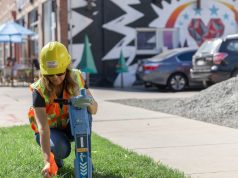Smart Cities would open up a host of new possibilities, improving the quality of our urban spheres and making them more connected with technology to provide a holistic living experience by reducing congested spaces, pollution and taking the basic architecture of urban planning models to a new trajectory.
Smart Cities are undoubtedly the future of urban habitation and various governments have started preparing the roadmap for developing existing cities.
Private players from across the segments are also excited at the multitude of opportunities that smart cities would offer. But there are also challenges in the path of Smart City development that arise from infrastructural constraints, slower adoption of technology, or other policy-related hurdles.
In an exclusive interview with Keith Mann, Esri Industry Manager for State & Local Government, we discuss the various facets of smart cities, the challenges, what is to be done, integration of different technologies, the role of ubiquitous mapping and location, and a lot more.

There are many problems faced by cities of the world, including pollution and shrinking spaces, how do you think Smart Cities would help in this regard and make our cities more livable and environmentally friendly?
One way that smart city technology applied location intelligence to the problem of pollution in an urban area experiencing it directly recently was the city of Flint, Michigan. After it was discovered that they had high levels of lead in their drinking water, GIS was used to identify what metal each pipe in the city was made of and where those pipes were located. In doing this, the city was able to see where the contaminated water was affecting specific homes more precisely than ever before, and it served as a model for drinking water mapping for utilities in the future.
What would be the role of GIS and geospatial in Smart Cities?
Location intelligence must be at the core of smart city planning and design. The role of GIS is to provide a trusted framework for decision-making and communication that everyone can use. There is a set of common patterns unique to GIS, which is as follows:
- Mapping and visualization that enhances the understanding of locations and relationships with maps and visual representation.
- Data Management tools for collecting, organizing, and maintaining accurate locations and details about assets and resources.
- Field mobility for managing and enabling a mobile workforce to collect and access information in the field.
- Monitoring of live data feeds to track and manage assets and resources in real-time.
- Spatial analytics for discovering, quantifying, and predicting trends and patterns to improve outcomes.
- Design and planning tools for evaluating alternative solutions and creating optimal designs.
- Decision support that provides situational awareness and enables information-driven decisions.
- Constituent engagement channels for communicating and collaborating with citizens and external communities of interest.
These frameworks can be used to do things that are incredibly valuable for a city, like identifying where investments should be made, where people are in need of help, and subsequently being able to monitor those areas to see whether progress is being made. All too often, communities commit to civic projects and then have no data on the effectiveness of the initiative, so they have no idea what worked or what didn’t. GIS provides a precise and accurate picture of this, so mistakes won’t be repeated, and successes can be reproduced.
Other than its existing forays in Smart Communities, how else can Esri assist in global Smart City projects? And what is the Esri vision for Smart Cities?
We live in an age of tremendous creativity and innovation. For local governments, this means taking new approaches to problem-solving—seeing the big picture but also understanding all the interconnected details; adapting quickly when necessary but simultaneously keeping the long-range view of a resilient and sustainable community.
Beyond that, innovation requires us to shake things up and do things differently. It’s not just about brainstorming or blue-sky thinking. It incorporates people’s experience and competence while considering how government processes, procedures, and systems could or should work to meet the goals and initiatives of its leadership. Smart initiatives are designed to improve the quality of our communities and meet citizen expectations when they interact with government.
A geographic information system (GIS) enables government staffs to easily tap into existing data and citizen feedback, and use that information to answer the most important questions about what is best for the community. However, a GIS is more than a map, it’s a communication channel that reveals underlying relationships and informs decision-making by placing you and what’s important to you within the context of geography.
For Esri, GIS or the Science of Where is about bringing community vision to life in a thoughtful and creative way. It provides the ability to challenge the status quo based on location intelligence, to respond faster with more confidence, and innovate with understanding.
Every city can become safer, healthier, better-run, sustainable, and more prosperous by understanding the data about a city’s functions in the context of their geography. By having this geospatial awareness, planners can know how to make the right investments in the right places at the right time, and citizens can see what is happening in their community. So, essentially, the Esri vision for a smart city is one which is completely connected through real-time location intelligence.
Smart Cities are certainly going to revolutionize urban planning, but do you think there is an adequate infrastructural base to support it? And if not what needs to be done to quicken the pace?
Yes, with a caveat: some cities have a head start. With the cities that have not yet updated their infrastructure sufficiently to support the technology that makes smart city innovations possible, the best way to jumpstart this transformation is by implementing a modern location intelligence system to have a deeper insight into urban assets. The first step towards becoming smarter and connected as a community, is understanding all the data that is already present in the context of its geography. Everything in a city function in the context of location. And that means all a city’s crucial data can and should be connected to specific places.
What do you think are other technologies that will play a leading role in the smooth transition to Smart Cities?
Real-time GIS opens the door to cities being able to take full advantage of IoT. Real-Time GIS provides the ability to simultaneously tap into, analyze, and display streaming data from many sensors, devices, and social media feeds. Maps and databases are continuously updated so that when things like natural disasters or large-scale emergencies strike, first responders have accurate, up-to-date information about the locations they need to get to in order to make the best decisions.
The groundwork for Smart Cities of the future would rely on the convergence of multiple technologies, particularly, AI, IoT, and drones. In this scenario, what do you think needs to be done to promote the large-scale adoption of these technologies?
The key to technology adoption is understanding. It’s easy to get confused by emerging tech like artificial intelligence (AI), autonomous vehicles, and the Internet of Things (IoT). Everyone, from city leaders to citizens, needs to understand how and, more importantly, where these technologies will benefit the community. Where will the power of these solutions have the greatest impact, or bring the most benefit? Where will citizens experience improvements in the quality of their lives and where should they not be applied?
AI will need to consider the spatial features of problems to bring true intelligence to solutions. Autonomous vehicles will need to conform to rules and regulations depending on where they are. Sensors, whether in motion or stationary, will become a new kind of infrastructure that cities will monitor, manage, and regulate.
The regulation of commercial and recreational drone use is a good example of how cities—even smart cities—slow the adoption of new technologies to grow their understanding of how and where the application of that technology is permissible, beneficial, or harmful. Smart mapping and spatial analytics provide a way to increase transparency, improve understanding, and invite collaboration between technology providers, users and citizens.
In your opinion, what should the municipal councils and other local bodies do to facilitate the adoption of technology?
Quite simply, enable everyone with the ability to discover, use, make, and share geographic information. This means that every policy maker, planner, analyst, fireman, police officer, business owner, and citizen has access to the maps and spatial information that helps them make decisions and understand how those decisions with affect them and their community.
Encourage everyone in each organization to learn about location intelligence technology. The key to wide-scale adoption is making non-GIS scientists understand that this can be not only helpful to them but a utility for them as well. A great tool to demonstrate this is ArcGIS Hub, a user-friendly online engagement platform that extends the city’s GIS data to the public to turn goals and aspirations into initiatives and action.
Durable and resilient infrastructure would be another factor in Smart Cities. So does this mean that all the other developments have to be hand-in-hand with the construction industry?
Being smart requires an open platform for sharing information and collaborating across city departments, with other communities, with partners, and enabling citizen participation. It should be easy for a local government to share plans and analyses with contractors, land developers, non-profits, or anyone who has a vested interest in the community. Reliable, timely, and accurate information in the form of maps and other relevant information products should be accessible through open portals and other GIS services.
Traditional infrastructure, such as roads and utilities, are already taking on new characteristics and capabilities that both local governments and construction companies will need to incorporate into their designs and requirements. Sensors will provide new ways to collect and monitor the disposition of infrastructure components in real-time. GIS is already a real-time technology and will be instrumental in the development of resilient infrastructure.
As Keith pointed out we can clearly see the imminent need for smart cities is an enabling technological framework and active, concerted participation from across the board.
Also Read:




